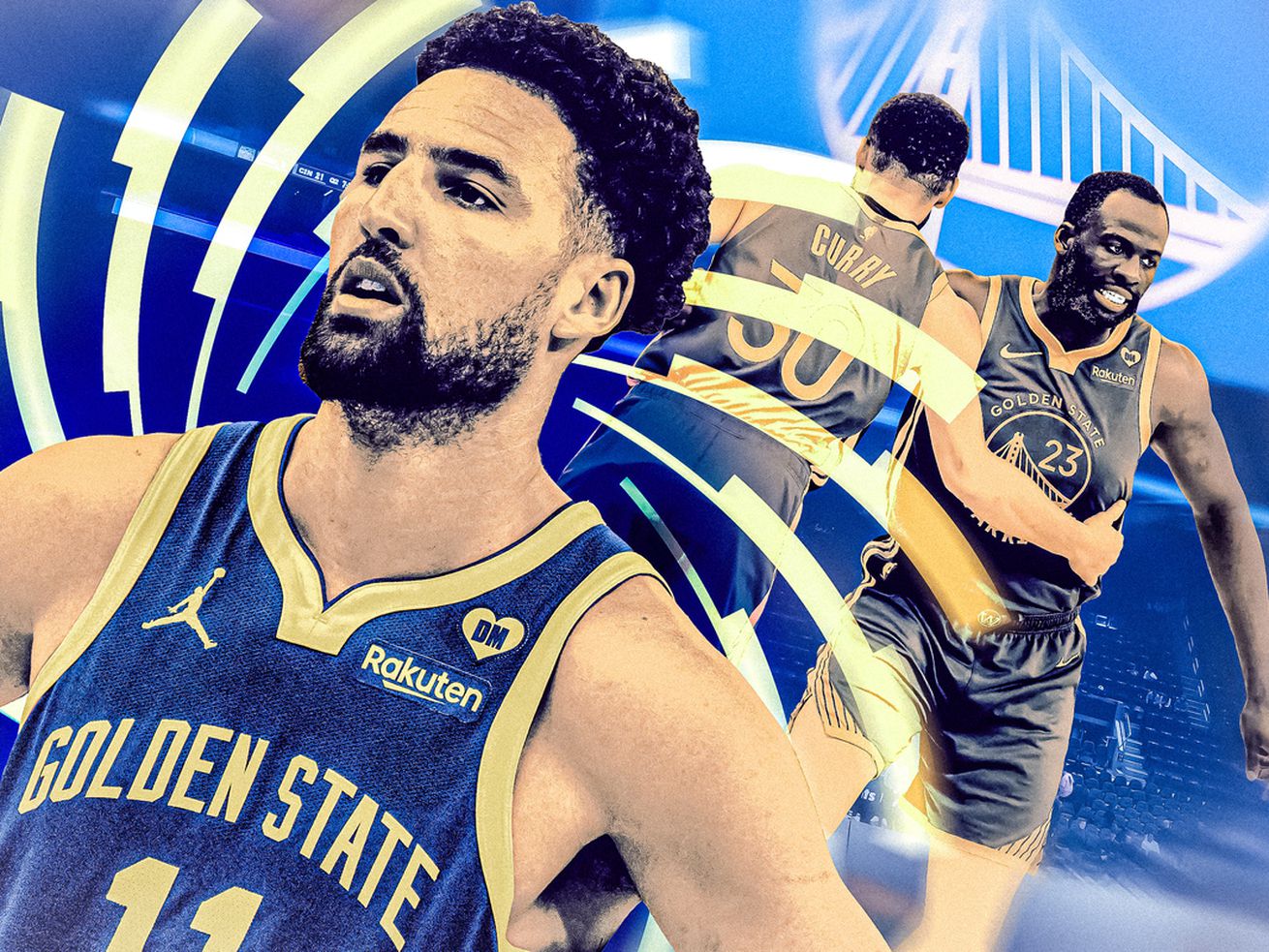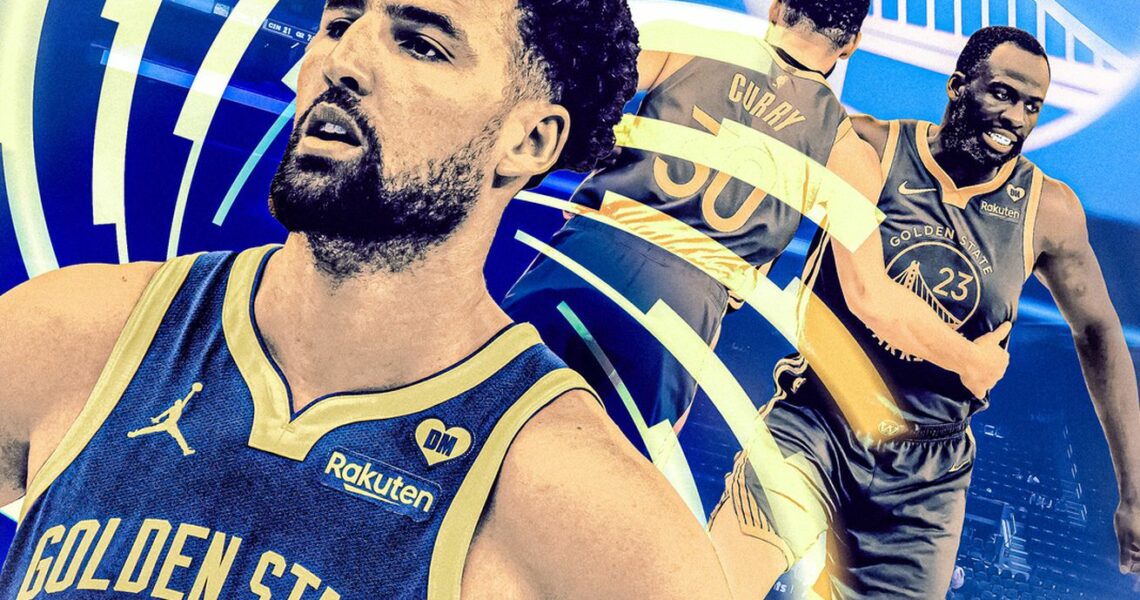
Klay Thompson’s free agency isn’t general manager Mike Dunleavy Jr.’s only order of business this summer, but it is the most symbolic. Will the Warriors follow their core to the end, or will they pursue a more drastic offseason reset around Steph Curry?
On Monday afternoon, Golden State Warriors general manager Mike Dunleavy Jr. stepped into an auxiliary room along the northern corridor of Chase Center equipped with the optimism necessary for this part of the NBA calendar.
“This time of year is fun,” he told reporters, as he sat on a makeshift stage, minutes into his predraft media availability. “You’ve got free agency, you’ve got trades, you’ve got the draft—all ways to improve your team.”
Dunleavy, in his second year as general manager, will need all the ingenuity he can summon, as the Warriors stand at their most consequential crossroads since Kevin Durant left in the summer of 2019. Last season, Golden State trotted out the league’s most expensive—and fourth-oldest—roster and limped its way to 46 wins and an elimination at the hands of the Kings in the play-in tournament. The early exit thrust the Warriors into a pivotal offseason, in which they must decide what kind of team they’ll be in the final years of Steph Curry’s career.
Golden State has pathways to facilitate major changes this summer. It holds the 52nd pick in this year’s draft, owns its first-round picks outright from 2025 to 2029, and has several players with uncertain futures. League sources believe Andrew Wiggins, who struggled to find a consistent role last season, will be aggressively dangled in trade talks. The Warriors are also working hard to find a trade partner for Chris Paul, whose non-guaranteed $30 million salary for 2024-25 could be useful for matching purposes—but they have only until Friday, the last day they can waive Paul before his deal becomes fully guaranteed for next season. (Unless Paul and the Warriors agree to push the guarantee date into July.) And the most polarizing offseason question is Klay Thompson, who is expected to test free agency for the first time in his career.
Before last season, Thompson turned down a two-year, $48 million extension, hoping to play his way into a more lucrative deal this summer. But even as he averaged 17.9 points and shot 39 percent from 3-point range, Thompson struggled to make a case that he’s worthy of another major payday. After reconstructive surgeries on his Achilles and ACL, the mobility that made Thompson one of the league’s best two-way players is greatly diminished, to the point that Warriors coach Steve Kerr demoted Thompson to the bench last season. And when his offense was needed in the biggest moments, Thompson failed to deliver, lowlighted by a 0-of-10 performance against the Kings in the Warriors’ final game of the season—and what could potentially end up as Thompson’s last game with the franchise.
“We want him back,” Dunleavy said. “We’ve said that all along.”
But according to league sources, negotiations between Thompson and Golden State’s front office have stalled as free agency draws near, and the two sides remain far apart on an agreement. The Warriors are sorting through their myriad other offseason questions first, while Thompson enters the summer a scorned man. In the past two seasons, he’s seen the Warriors commit more than $300 million in contracts, including nine-figure extensions to Wiggins and Jordan Poole. Last summer, Draymond Green received a four-year, $100 million deal with a player option, even as his behavior made him unreliable and eroded team chemistry. Thompson seems to be the victim of a new tack for the Warriors: After years of astronomical spending, CEO Joe Lacob has mandated that the team shed salary. Now, Dunleavy has to strike a balance between financial austerity and the ultimate goal of bringing the Larry O’Brien Trophy back to Northern California.
“I think I’m reasonable, I’m rational. That’s how I’m always going to operate,” Dunleavy said when asked about the emotions involved in a negotiation with an organizational cornerstone. “But to say a guy like Klay Thompson, who has meant so much to this franchise, to completely strip the emotion away from it, I think that’s almost impossible.
“But this is a business,” he added. “We’ll talk through things and continue to talk through things. Like I said, we are hopeful, but, you know, we’ll see. We’ve got to figure things out.”
Regardless of whether Thompson walks away or returns in a smaller role, the Warriors need a more suitable costar in San Francisco—and it’s unclear whether they have enough to acquire one. When Golden State won the title two springs ago, Wiggins was its second-best player, but that distinction has waned as he’s fallen off, missed extended time, and struggled to play next to Jonathan Kuminga. Kuminga, who averaged 16.1 points and 4.8 rebounds while shooting 53 percent from the field in a breakout 2023-24 campaign, is eligible for an extension this summer and is at the top of Golden State’s list of players to retain, with some analysts projecting he’d be worth more than $100 million on the open market. But Kuminga’s inconsistency casts doubt on whether he can become a no. 2 option, especially on Curry’s timeline. Golden State trotted out some other impressive young players last season—rookie guard Brandin Podziemski made first-team All-Rookie, while first-year big man Trayce Jackson-Davis started 16 games, effectively taking franchise stalwart Kevon Looney’s place in the rotation—who could be tantalizing in a trade for a star, but Dunleavy will be hesitant to include them in deals.
“We really value those guys. We’ve drafted them. We’ve grown them,” Dunleavy said. “They have played really well. We are excited about them. A scenario to move them would take a lot. It’s important for us to be good now and then be good also in the future. But the main thing is, we think those guys can contribute and help our group now. If that was not the case, we would be more open to stuff, but it is.”
Even if there is a deal to be struck, there doesn’t seem to be a player on the market who can fit with the roster and elevate the Warriors back to the mountaintop. On Monday, Dunleavy used a cautious tone when describing the Warriors’ attitude toward the trade market.
“It’s having a willing partner,” he said. “I think to do that, you’ve got to find the right time. … I’m calling everybody, but if the player is not available and there’s not a price, then there’s no trade that can be made.”
Golden State’s offseason is made even more daunting by the league’s collective bargaining agreement, which further limits the Warriors’ spending and trade options. The CBA imposes harsh restrictions on teams that repeatedly spend over the luxury tax threshold, which is currently projected to be $172 million, just below the $174 million Golden State already has on the books. In February, Lacob stated his desire to get the Warriors below the tax, but Dunleavy says the mandate could be negotiable.
“It’s more like if there’s a point to go over the tax, if there’s a point to going into one of the aprons, we will do it,” he said. “Because the most important thing to him is winning. He’s shown that.”
Which means the biggest test for Golden State is time. Curry turned 36 in March, and Green and Thompson are 34. The Western Conference projects to be an absolute gauntlet moving forward; several young teams have already passed the Warriors and are just at the beginning of their upward swings. But as long as Golden State employs Curry—the greatest player in franchise history, who earned his 10th All-NBA selection in 2023-24—championships will be the driving force behind every move. That leaves Dunleavy with the difficult quandary of juggling Curry’s ambition with the realities of a depleted post-dynastic roster.
“I think we have to be realistic, and I don’t want to, like, press and overdo something,” Dunleavy says. “Some patience needs to take place while at the same time recognizing this time horizon we have with Steph and Draymond and hopefully Klay. As those guys get a little bit older, we have to be mindful at a point they are not at a level to compete for a championship. I don’t think that’s, like, too near, but at some point, it probably will be.”
Last offseason, the Warriors were just a year removed from a title, and it made sense to keep the band together. Now, after another step back, Dunleavy finds himself steering the ship toward an existential reckoning one way or another. Will he bring the core back once again, or will he pursue a more drastic reset around Steph? This summer is a proving ground for Dunleavy, who is trying to revive the NBA’s most recent dynasty. Now, he’s hoping he hasn’t run out of time, and options, to achieve that goal.
“All things will be on the table,” Dunleavy says. “We’ll explore options and, just like we do every year, make the right decision and roll with it.”

